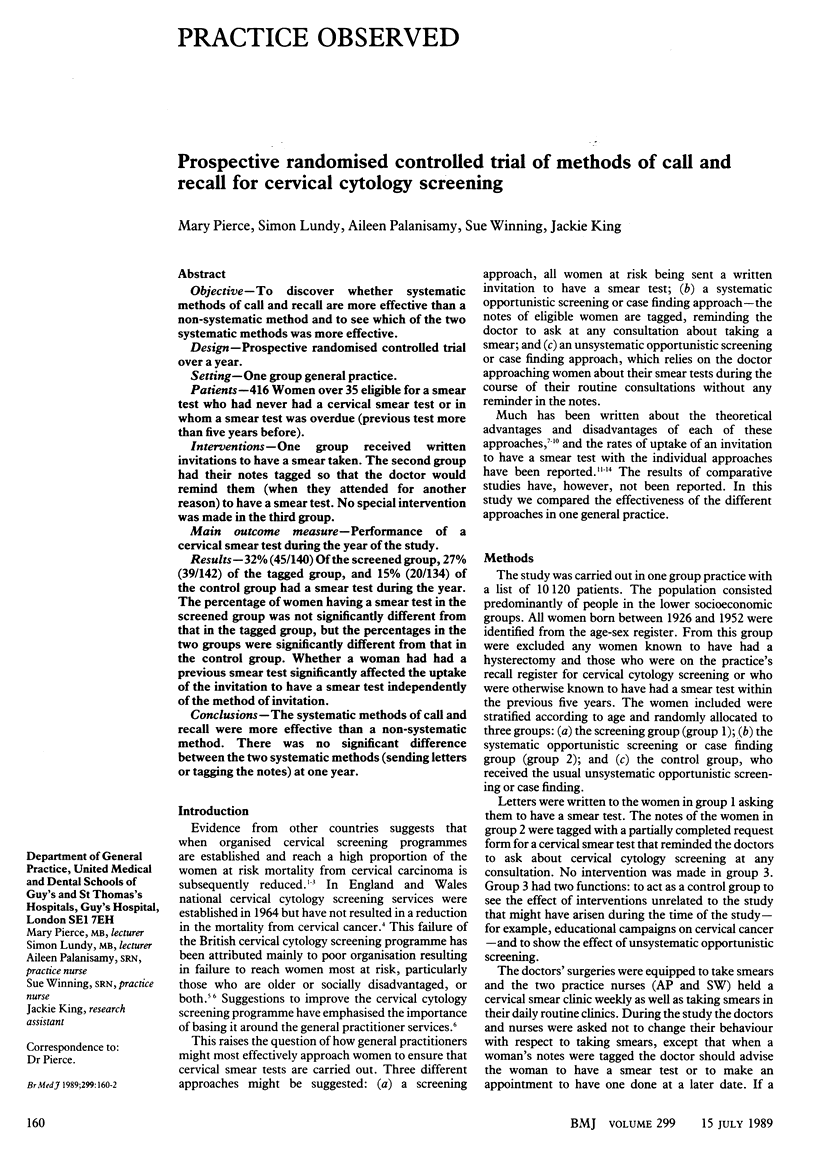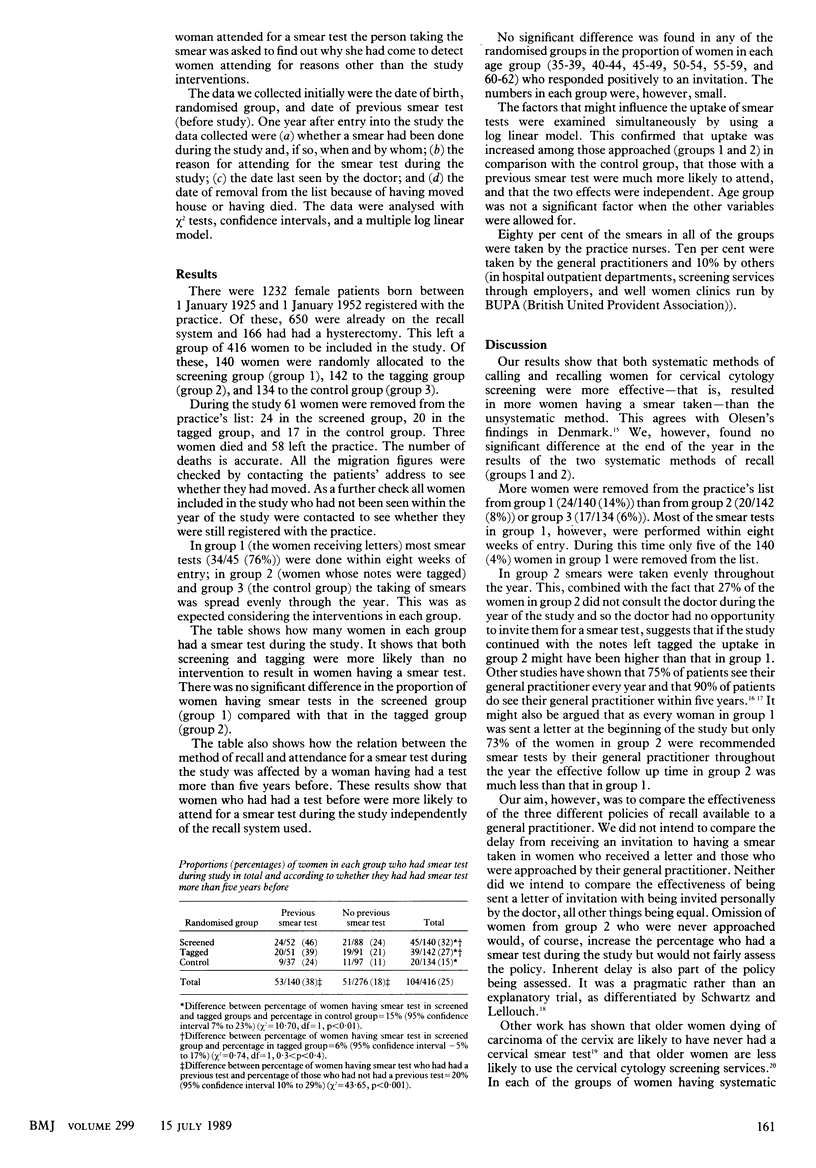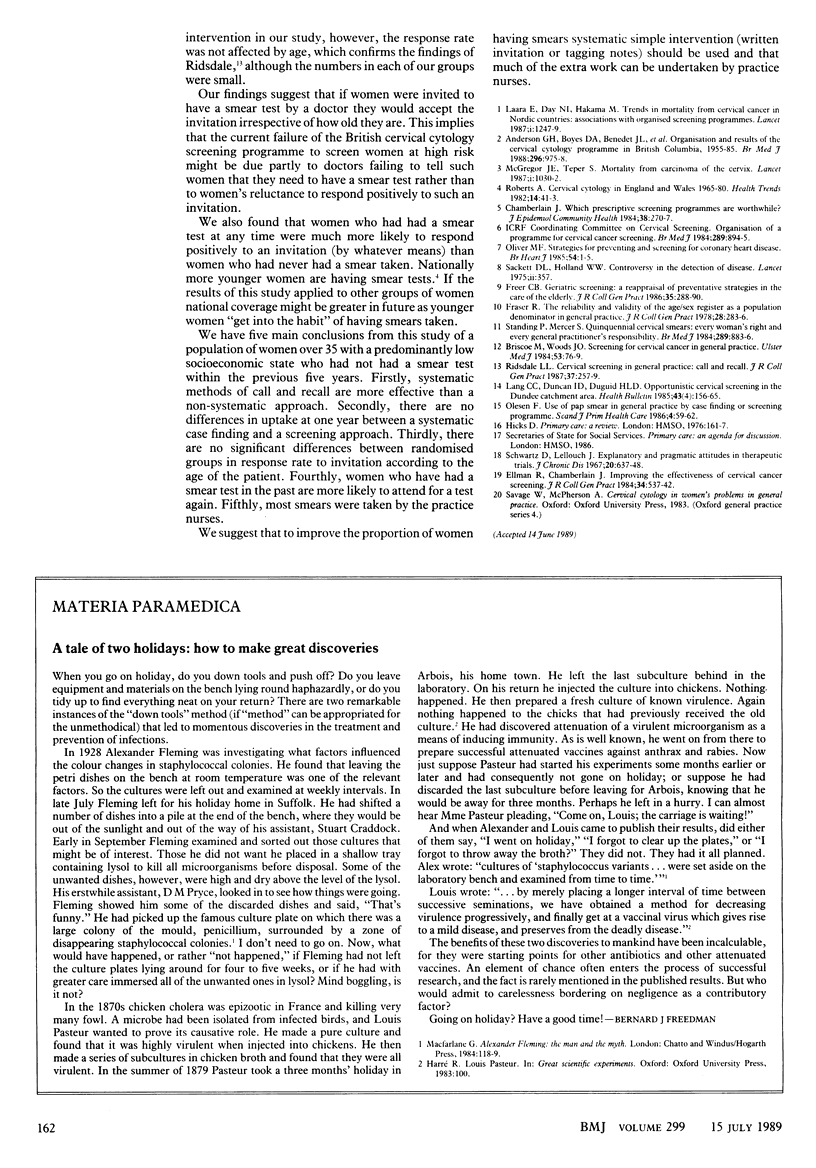Abstract
OBJECTIVE--To discover whether systematic methods of call and recall are more effective than a non-systematic method and to see which of the two systematic methods was more effective. DESIGN--Prospective randomised controlled trial over a year. SETTING--One group general practice. PATIENTS--416 Women over 35 eligible for a smear test who had never had a cervical smear test or in whom a smear test was overdue (previous test more than five years before). INTERVENTIONS--One group received written invitations to have a smear taken. The second group had their notes tagged so that the doctor would remind them (when they attended for another reason) to have a smear test. No special intervention was made in the third group. MAIN OUTCOME MEASURE--Performance of a cervical smear test during the year of the study. RESULTS--32% (45/140) of the screened group, 27% (39/142) of the tagged group, and 15% (20/134) of the control group had a smear test during the year. The percentage of women having a smear test in the screened group was not significantly different from that in the tagged group, but the percentages in the two groups were significantly different from that in the control group. Whether a woman had had a previous smear test significantly affected the uptake of the invitation to have a smear test independently of the method of invitation. CONCLUSIONS--The systematic methods of call and recall were more effective than a non-systematic method. There was no significant difference between the two systematic methods (sending letters or tagging the notes) at one year.
Full text
PDF


Selected References
These references are in PubMed. This may not be the complete list of references from this article.
- Anderson G. H., Boyes D. A., Benedet J. L., Le Riche J. C., Matisic J. P., Suen K. C., Worth A. J., Millner A., Bennett O. M. Organisation and results of the cervical cytology screening programme in British Columbia, 1955-85. Br Med J (Clin Res Ed) 1988 Apr 2;296(6627):975–978. doi: 10.1136/bmj.296.6627.975. [DOI] [PMC free article] [PubMed] [Google Scholar]
- Chamberlain J. M. Which prescriptive screening programmes are worth while? J Epidemiol Community Health. 1984 Dec;38(4):270–277. doi: 10.1136/jech.38.4.270. [DOI] [PMC free article] [PubMed] [Google Scholar]
- Ellman R., Chamberlain J. Improving the effectiveness of cervical cancer screening. J R Coll Gen Pract. 1984 Oct;34(267):537–542. [PMC free article] [PubMed] [Google Scholar]
- Fraser R. C. The reliability and validity of the age-sex register as a population denominator in general practice. J R Coll Gen Pract. 1978 May;28(190):283–286. [PMC free article] [PubMed] [Google Scholar]
- Freer C. B. Geriatric screening: a reappraisal of preventive strategies in the care of the elderly. J R Coll Gen Pract. 1985 Jun;35(275):288–290. [PMC free article] [PubMed] [Google Scholar]
- Lang C. C., Duncan I. D., Duguid H. L. Opportunistic cervical cytology screening in the Dundee catchment area. Health Bull (Edinb) 1985 Jul;43(4):156–166. [PubMed] [Google Scholar]
- Lără E., Day N. E., Hakama M. Trends in mortality from cervical cancer in the Nordic countries: association with organised screening programmes. Lancet. 1987 May 30;1(8544):1247–1249. doi: 10.1016/s0140-6736(87)92695-x. [DOI] [PubMed] [Google Scholar]
- Olesen F. Use of Pap smear in general practice by case finding or screening programme. Scand J Prim Health Care. 1986 Feb;4(1):59–62. doi: 10.3109/02813438609013973. [DOI] [PubMed] [Google Scholar]
- Oliver M. F. Strategies for preventing and screening for coronary heart disease. Br Heart J. 1985 Jul;54(1):1–5. doi: 10.1136/hrt.54.1.1. [DOI] [PMC free article] [PubMed] [Google Scholar]
- Ridsdale L. L. Cervical screening in general practice: call and recall. J R Coll Gen Pract. 1987 Jun;37(299):257–259. [PMC free article] [PubMed] [Google Scholar]
- Sackett D. L., Holland W. W. Controversy in the detection of disease. Lancet. 1975 Aug 23;2(7930):357–359. doi: 10.1016/s0140-6736(75)92790-7. [DOI] [PubMed] [Google Scholar]
- Schwartz D., Lellouch J. Explanatory and pragmatic attitudes in therapeutical trials. J Chronic Dis. 1967 Aug;20(8):637–648. doi: 10.1016/0021-9681(67)90041-0. [DOI] [PubMed] [Google Scholar]
- Standing P., Mercer S. Quinquennial cervical smears: every woman's right and every general practitioner's responsibility. Br Med J (Clin Res Ed) 1984 Oct 6;289(6449):883–886. doi: 10.1136/bmj.289.6449.883. [DOI] [PMC free article] [PubMed] [Google Scholar]


